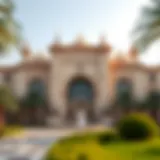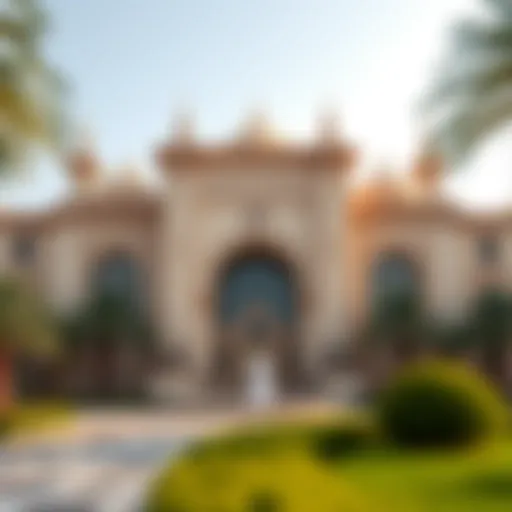The Architectural Grandeur of Dubai's Iconic Structures
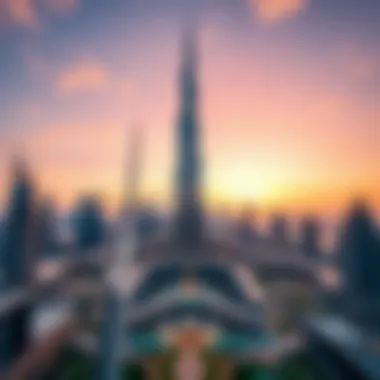

Intro
Dubai's landscape is a testament to human imagination and grand designs. The desert city has transformed into a bustling hub of the extraordinary, filled with structures that stretch the limits of traditional architecture. Not just about reaching for the sky, these buildings tell a story—of ambition, culture, and modernity. Indeed, as we journey through the architectural lineage of Dubai, we catch a snapshot of the city's evolution from humble beginnings to the luxurious metropolis it is today.
Every corner of Dubai offers a lesson in architecture, where East meets West, and tradition dances with innovation. From the sloping lines of the Burj Khalifa to the intricate details of the Jumeirah Mosque, each structure contributes to the colorful narrative of the city's heritage. As the world sets its gaze upon these impressive feats, the influence of architecture extends far beyond mere aesthetics, impacting the property market and attracting investors from every nook and cranny of the globe.
As we delve into the architectural wonders, we also uncover how they play a pivotal role in shaping investor confidence and property trends. This article serves to not only illuminate the exceptional buildings that punctuate the skyline but also to explore how they resonate within the broader scope of Dubai's real estate landscape.
Prolusion to Architectural Beauty
In a city that constantly pushes the envelope, the importance of architectural beauty in Dubai cannot be overstated. The essence of this beauty intertwines with the culture, history, and aspirations of its inhabitants. Beautiful buildings are not merely structures; they represent a visual narrative of a society's evolution, reflecting both its progress and identity. Understanding this architectural beauty is crucial for investors, homeowners, and professionals alike, as it fosters an appreciation for the nuances that define Dubai's unique skyline.
Defining Architectural Beauty
Architectural beauty, in the context of Dubai, encompasses various elements that contribute to a structure's allure. It's not just about the height or the materials used; it's a symphony of design techniques, cultural references, and innovative engineering. For instance, when one looks at the Burj Khalifa, what stands out is not just its towering stature but also the way it blends modernity with the traditions of its surroundings. The sleek glass façade reflects the ever-changing sky, while its silhouette pays homage to local minarets, making it a quintessential example of how architectural beauty can bridge the past and the present.
Moreover, the definition of beauty in architecture can also extend to sustainability aspects, where environmentally friendly design practices play a role. In Dubai, several buildings have integrated green technology seamlessly into their designs, creating a functional yet aesthetically pleasing environment. Overall, defining architectural beauty in this context reveals the complex layers of thought and expression that have led to the stunning landscapes we see.
The Significance of Aesthetic Design
Aesthetic design goes beyond mere visual appeal—it's about creating spaces that resonate with their surroundings and serve the community at large. In Dubai, the aesthetic choices made in architectural design enhance not only the beauty of individual structures but also the city as a whole.
- Cultural Resonance: Structures like the Dubai Opera stand as cultural beacons, harmonizing artistic pursuit with architectural flair. Their aesthetic design fosters a connection to the city's cultural heritage while attracting visitors and locals alike.
- Public Interaction: Buildings like The Palm Jumeirah and other waterfront developments embody aesthetic design that encourages interaction. Whether it’s the vibrant walkways or lively public spaces, such designs stimulate engagement within communities.
- Market Appeal: Investors and homeowners also find great value in aesthetically pleasing buildings. Such designs tend to hold market value better over time and attract premium buyers who appreciate both form and function.
In summary, the significance of aesthetic design in Dubai is profound. It shapes experiences, defines cultural narratives, and ultimately, enhances the investment landscape, making it integral to discussions surrounding architectural beauty.
Historical Context of Dubai's Architecture
The architectural landscape of Dubai is a fascinating blend of history, culture, and modernity. Understanding this historical context sheds light on the remarkable transformation the city has undergone over the decades. From humble beginnings as a fishing village to a global hub of business and tourism, Dubai's architectural journey is a reflection of its ambition and the cultural narratives that shaped it. This section delves into the importance of historical context in Dubai's architecture, emphasizing how these elements influence not only aesthetic appeal but also community identity and economic viability.
From Traditional to Modern
Dubai's architectural evolution has been anything but linear. In the early days, the structures were designed for practicality and function. Buildings were predominantly made from coral stone, mud, and palm fronds, reflecting the harsh desert environment. The Barjeel, or wind tower, is one example of traditional architecture that served a dual purpose—providing ventilation and cooling in the hot climate.
As Dubai flourished, particularly during the oil boom of the 1970s, modern materials and methods began to take precedence. These developments ushered in a new class of skyscrapers and luxury resorts that defined the modern skyline, shifting the focus from utility to grandeur.
Developments such as the Burj Al Arab, which opened in 1999, symbolized this shift, integrating opulence into the architectural narrative of Dubai. The dazzling facade and unique sail shape capture the city's desire to present itself as an international city, attracting both business and tourism. In essence, while the transition from traditional to modern architecture reflects global trends, it also highlights local aspirations and identity.
Influence of Cultural Heritage
Cultural heritage plays a pivotal role in shaping Dubai’s architecture, creating a dialogue between the past and the present. The city serves as a melting pot, where diverse communities coexist and contribute to its architectural narrative.
Islamic design principles, characterized by intricate geometric patterns and calligraphy, continue to influence contemporary buildings. Structures like the Dubai Frame exemplify this blend, bridging the traditional motifs with modern aesthetics. By embedding cultural references in modern developments, architects ensure that historical significance is not lost.
Moreover, community spaces such as the Dubai Creek area preserve traditional Emirati culture, offering a glimpse into the past amid the urban sprawl. The juxtaposition of old and new highlights the dynamic nature of Dubai’s architectural vision. This respect for heritage informs both design philosophy and urban planning, a critical aspect when considering future developments.
"Architecture is not just about creating buildings, but about creating spaces that tell the story of a community."
Iconic Structures of Dubai
The architectural landscape of Dubai stands as a testament to human ingenuity and creativity. Each structure tells a story, contributing to the character and essence of the city. Among these are buildings that have become symbols of innovation, luxury, and cultural significance. Understanding these iconic structures is fundamental for anyone who wishes to grasp the architectural identity of Dubai.
Burj Khalifa: A Pinnacle of Innovation
The Burj Khalifa, soaring at 828 meters, isn't just the tallest building in the world; it embodies a monumental leap in architectural design and engineering. Completed in 2010, this skyscraper represents the pinnacle of human ambition and adaptability. It’s not just about height; the Burj Khalifa integrates advanced technologies designed to sustain performance in the sweltering Dubai climate.
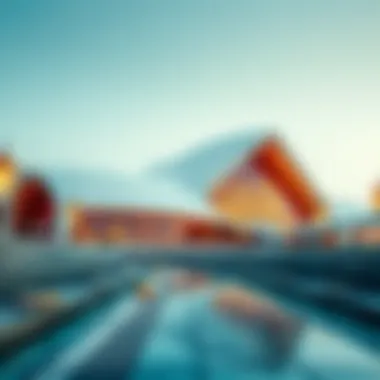

The design draws inspiration from the Islamic architecture of the region, yet it pushes boundaries into what modern poetry can articulate in steel and glass. For instance, its Y-shaped floor plan maximizes views and reduces wind forces, a brilliant consideration in aerodynamic design. With observation decks on the 148th floor, the building offers breathtaking vistas of the sprawling metropolis and the desert beyond.
Investors often view the Burj Khalifa as more than a landmark; it's a symbol of prestige. Properties nearby have increased substantially in value due to the desirability of living close to such an iconic structure. The Burj has fostered a real estate boom in surrounding areas, defining luxury living in Dubai.
The Palm Jumeirah: A Man-made Marvel
Emerging from the azure waters of the Arabian Gulf, the Palm Jumeirah is a feat of engineering that comprises a series of linked islands shaped like a palm tree. This extraordinary development, completed in 2006, reflects Dubai's ambition to push the limits of architectural possibilities.
Beyond its breathtaking design, the Palm Jumeirah hosts some of the most luxurious hotels and residential areas globally. Home to the famed Atlantis, The Palm, the island attracts tourists and inhabitants alike, encapsulating the essence of a holiday paradise. The monorail that runs down the island adds to its connectivity, ensuring ease of access.
From a real estate perspective, the Palm Jumeirah has shown resilience and growth, making properties here highly sought after. The unique waterfront lifestyle it presents appeals to affluent buyers willing to invest in this exclusive locale.
Dubai Opera: A Cultural Landmark
Dubai Opera stands as a cultural jewel amid the architectural wonders of the city. Opened in 2016, this multi-format venue has transformed the cultural scene in Dubai. Resembling a traditional dhow, it symbolizes Dubai's maritime heritage while exhibiting contemporary design aesthetics.
The versatile space can host a variety of events, from opera and ballet to concerts and conferences. This flexibility not only enriches the local cultural fabric but also plays a significant role in enhancing the tourism sector.
Investors recognize the cultural value of the Dubai Opera as it contributes to the surrounding property values. The establishment of such a landmark fosters a sense of community and increases demand for real estate in the vicinity.
In summary, the iconic structures of Dubai are not merely aesthetic contributions to the skyline; they are pivotal in shaping the urban landscape, driving economic growth, and fostering community life. From the soaring heights of the Burj Khalifa to the enchanting curves of the Palm Jumeirah and the artistic allure of the Dubai Opera, each building tells a story of ambition and innovation.
Architectural Styles in Dubai
The architectural landscape in Dubai is a vivid tapestry woven from various styles and influences. This diversity is not merely aesthetic but also reflects the city’s aspirations, cultural narratives, and historical evolution. Understanding architectural styles in Dubai offers insight into the city's identity and growth. Different architectural approaches support unique uses, engage communities, and set benchmarks for sustainability. As such, they are pivotal in shaping the livability and functionality of urban spaces.
Contemporary Architecture Trends
Dubai showcases a striking blend of groundbreaking contemporary architecture. With soaring glass facades and an innovative spirit, notable buildings like the Burj Khalifa and the Museum of the Future embody the cutting edge of design and engineering. contemporary architecture in Dubai often embraces concepts of openness and light, creating harmonious spaces while paying heed to environmental concerns.
Utilizing sustainable materials and smart technologies, many structures aim to minimize their carbon footprint. Green roofs and solar panels are becoming more common, illustrating a shift towards environmentally responsible designs.
Key Characteristics of Contemporary Architecture in Dubai:
- Sustainability: Energy-efficient buildings reduce reliance on fossil fuels, employing techniques like passive cooling and natural lighting.
- Technology Integration: Smart building systems are increasingly adopted to enhance efficiency and comfort.
- Cultural References: Many contemporary buildings reference local heritage, marrying modernity with tradition, thereby creating a unique sense of place.
These trends are not mere fads—they signal a long-term commitment to innovation and sustainability, aligning with the city’s strategic goals to be a global leader in sustainable practices.
Integration of Islamic Design
Traditional Islamic architecture heavily influences modern designs in Dubai. This integration is evident in ornamental details, geometrical patterns, and calligraphy, which serve as cultural anchors amidst rapid modernization.
Islamic architecture is characterized by features such as:
- Arches and Domes: These elements not only enhance visual appeal but also aid in thermal comfort.
- Courtyards: Common in older structures, they promote air circulation and natural cooling, making them relevant to contemporary designs as well.
- Mashrabiya: This traditional wooden latticework allows for natural light while preserving privacy.
By incorporating these elements into modern buildings, architects create spaces that resonate with the local community. For instance, the Al Bahar Towers utilize dynamic shading systems inspired by Islamic design to combat the desert heat while adding aesthetic value.
The successful fusion of these traditional elements with contemporary styles illustrates how Dubai honors its cultural roots, even amid an ever-evolving skyline. This approach not only adds depth to the architectural narrative but also attracts investors seeking authenticity in a global market.
“Architecture is both a reflection of cultural values and a catalyst for future innovations.”
In essence, the architectural styles in Dubai encapsulate the city’s journey of transformation, making it a blueprint for the future where aesthetics, functionality, and cultural identity harmonize seamlessly. With every new building, Dubai reinforces its status as a global architectural hub.
The Role of Sustainability in Architecture
Sustainability in architecture goes beyond just buzzwords. In a rapidly changing world where environmental concerns are rising, it's becoming paramount for modern structures to reflect an awareness of their ecological footprint. In Dubai, where the architectural landscape is both stunning and diverse, the role of sustainability holds significant relevance. This isn't merely about building structures that are visually appealing; it’s about ensuring they live in harmony with the environment and are socially responsible.
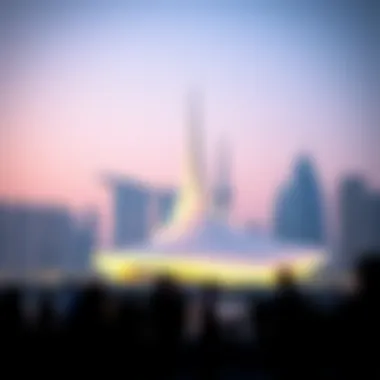

From energy efficiency to water conservation, sustainable architecture is a bridge between luxury living and environmental protection. As one of the world’s fastest-growing cities, Dubai’s commitment to sustainability is crucial, not only for its citizens but also for the millions of visitors it attracts. The green building practices adopted here aim to minimize waste, maximize energy efficiency, and promote healthy living conditions. Therefore, it’s not just about the aesthetic value of these beautiful buildings; it’s about their functionality and longevity in addressing climate challenges.
"The future of architecture in Dubai must be a harmonious blend of beauty, culture, and sustainability."
Green Building Practices
Adopting green building practices is an essential step towards realizing sustainable architecture in Dubai. This involves using materials and methods that reduce the overall environmental impact of construction. Some key practices include:
- Use of Renewable Resources: Many builders are turning to materials that reduce energy consumption, such as locally sourced stone and recycled metals.
- Energy Management Systems: Smart technologies are increasingly integrated into buildings to optimize energy use. For instance, buildings equipped with solar panels can harvest energy, significantly lowering reliance on non-renewable sources.
- Water Management: Dubai's climate poses challenges for water conservation. Implementing rainwater harvesting systems and advanced irrigation techniques ensures an efficient approach to water use within urban developments.
- Green Spaces: Integrating parks and vertical gardens in architectural designs not only enhances aesthetics but also improves air quality and provides habitats for local wildlife.
By employing these practices, developers can create spaces that are not only visually striking but contribute actively to environmental well-being. These buildings do not just benefit their immediate occupants; they act as catalysts for broader change in community awareness and responsibility.
Future of Sustainable Architecture in Dubai
As Dubai continues to evolve, the future of sustainable architecture looks promising. With the city aiming to pioneer green initiatives, several anticipations arise:
- Increased Legislation Support: The Dubai government may implement stricter regulations that encourage sustainable building practices to meet global standards, making it technically easier to invest in green initiatives.
- Technological Advancements: Innovations like smart building materials that respond to environmental cues (e.g., temperature changes) will likely become commonplace, drastically increasing efficiency.
- Public Awareness: As more residents understand the benefits of sustainability, demand for green features will rise, pushing developers to prioritize sustainability within their projects.
- Global Partnerships: Dubai may foster collaborations with international sustainability firms that bring fresh insights and technologies to the forefront of construction.
The architectural direction taken by Dubai today sets the stage not just for a harmonized city but a model for urban spaces worldwide. Striking a balance between opulence and eco-friendliness will not only enhance the reputation of Dubai as a leading architectural hub but also instill a sense of responsibility among future generations. It’s an evolution that reflects the city’s commitment to building not just for today, but for a better tomorrow.
The Impact of Architecture on Real Estate
Architecture holds a prominent place intersecting real estate in Dubai, a city famed for its opulent structures and skyline painted with beauty. Understanding this connection allows investors, homeowners, and professionals to gauge the substantial implications of architectural design on property value and market dynamics.
Market Value and Architectural Design
The aesthetic appeal of a building is not just skin deep; it plays a pivotal role in determining its market value. In Dubai, where the skyline is a testament to architectural innovation, properties designed with a keen eye for detail and artistic flair often attract higher valuations. An iconic structure like the Burj Khalifa sets a precedent, boosting surrounding property values through its uniqueness and tourist draw.
Consider these elements when evaluating market value in relation to architectural design:
- First Impressions: The exterior design of a property can inspire confidence and evoke excitement. A well-crafted facade can transform a mere building into a neighborhood landmark, making it a conversation starter.
- Building Materials: High-quality materials signal longevity and attractiveness. Structures that utilize glass, steel, or sustainable materials often command better prices. This, in turn, benefits resale potential.
- Sustainability Features: Green buildings are gaining traction. Properties with eco-friendly designs not only meet modern demands but can receive certifications that elevate their market worth. This includes features like solar panels or energy-efficient systems.
Ultimately, the relationship between architecture and market value is clear: attractive and thoughtfully designed buildings can lead to increased demand and elevated prices.
Investment Opportunities in Architectural Marvels
In a city bustling with innovation, Dubai's architectural feats present robust investment opportunities. Investors looking to navigate the Dubai real estate market should keep an eye on properties that stand out because of their architectural distinction. Buildings designed by world-renowned architects or those that incorporate novel design philosophies typically hold an allure that guarantees a steady return on investment.
Here are some key considerations when scouting for investment opportunities:
- Cultural Appeal: Properties that reflect cultural narratives tend to resonate with both locals and tourists. Think about how The Dubai Opera does just that—it’s more than just a venue; it encapsulates a cultural experience.
- Signature Projects: Investing in branded residences or signature structures associated with luxury brands can lead to substantial financial upside. They not only attract buyers but also elevate neighborhood status.
- Combined Spaces: Mixed-use developments that marry commercial and residential spaces offer versatility and increased foot traffic, enhancing property values in the long run.
"In Dubai, architectural brilliance isn’t merely an aesthetic choice; it’s a significant driver for investment success."
Community and Urban Planning
Community and urban planning holds immense significance in shaping the physical, social, and economic landscape of Dubai. The city’s rapid expansion demands a meticulous approach to architectural design that harmonizes with the community’s growth and developmental needs. In this bustling metropolis, the structures aren’t just isolated achievements of design but are interwoven into the tapestry of daily life.
An effective community planning strategy fosters a sense of belonging among residents, blends cultural heritage with modern conveniences, and promotes sustainability. This not only enhances the quality of life but also boosts property values, attracting potential investors and homeowners alike.
Role of Architecture in Urban Development
Architecture significantly dictates the character of urban development. It serves not merely as a shelter or a utility but as a statement, influencing how communities interact with their environment. For instance, the design of communal areas like parks and plazas can catalyze social interaction, bridging gaps between diverse populations.
Such integration cultivates a sense of community and supports local businesses. Thoughtful urban development leads to the creation of multipurpose spaces, which can be used for markets, gatherings, or recreational activities. Moreover, when buildings are strategically placed, they orchestrate the flow of life through the city, making daily activities more enjoyable and efficient.
The Dubai Marina, for example, stands as a testament to inspirational urban architecture. It combines residential towers with commercial spaces and waterfront promenades, ensuring vibrancy and accessibility. This careful consideration of architecture not only enhances the aesthetic appeal of the city but also fortifies its functionality, allowing residents to experience a seamless mix of living, working, and leisure activities.
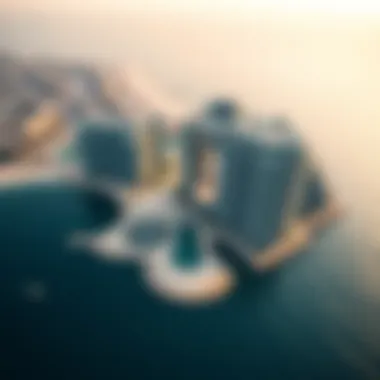

Architectural Influence on Community Spaces
The impact of architecture on community spaces in Dubai cannot be overstated. Beautiful buildings do not merely fill empty plots; they transform neighborhoods. Engaging architectural forms invite curiosity and draw people in, making public areas dynamic hubs of activity.
Public art installations and pedestrian-friendly designs encourage social engagement. For instance, the Alserkal Avenue area has emerged as a cultural district thanks to its innovative warehouse-style galleries and open-air spaces that host events. Such venues serve as nodal points where culture and community converge.
The essence of community spaces lies in their ability to reflect the diverse fabric of society.
In addition, architectural considerations around accessibility ensure that everyone can benefit from these spaces. Effective use of materials, landscaping, and infrastructure encourages inclusivity, thus allowing broader segments of the population to participate in community life.
When planning urban centers, sustainability and environmental consciousness are crucial as well. Smart designs can lead to energy-efficient buildings, which may reduce the community's overall carbon footprint while enhancing the livability of the area. This is increasingly pressing in a global climate that challenges urban centers to innovate and adapt.
In summary, community and urban planning are intertwined with the architectural landscape of Dubai. Each building contributes to the city's identity and its capacity to shape social interactions, fostering a cohesive environment where residents can thrive. As we look to the future, the lessons learned from Dubai’s architectural progression present both challenges and opportunities that resonate far beyond its borders.
The Future of Beautiful Buildings in Dubai
The architectural landscape of Dubai is not static; it’s a living, breathing organism that continues to evolve with every passing year. As we look to the future, it becomes increasingly clear that the designs and structures emerging on the horizon will not only redefine the skyline but also our experiences within the urban environment. The future of beautiful buildings in Dubai holds rich significance; it stands at the intersection of innovation, sustainability, and cultural sensitivity.
Specific elements to consider include:
- Technological Advancements: Innovations in building materials and construction techniques.
- Sustainability: A growing emphasis on eco-friendly structures and practices.
- Cultural Integration: The need to reflect the local culture and identity in modern designs.
- Smart Homes and Buildings: The incorporation of technology to enhance living experiences and improve efficiencies.
As Dubai aims to cement its place as a global leader in architecture and urban design, understanding these factors helps investors and home buyers anticipate potential property values and desirability. The importance of seamless integration of these elements cannot be overstated.
Anticipated Trends in Design
The architectural designs on the horizon for Dubai reflect wider global trends, yet they maintain unique characteristics rooted in local culture. Several anticipated trends stand out:
- Vertical Cities: With limited land space, structures are becoming taller, housing both residential and commercial spaces, all within the same skyline.
- Sustainable Architecture: Buildings that utilize renewable energy sources, green roofs, and materials that are not only durable but also eco-friendly.
- Mixed-Use Developments: These are increasingly popular, combining residential, commercial, and recreational spaces, encouraging a live-work-play model.
- Biophilic Design: Incorporating natural elements into architectural designs—like gardens integrated into buildings—to enhance well-being and connection with nature.
The implications of these designs are profound, as they plan for not just how we live today, but how future generations will engage with their space.
Impact of Globalization on Local Architecture
Dubai’s identity as a melting pot is reflected in its architecture, where globalization leaves a distinct mark. Though this influence can be seen as a double-edged sword, it’s essential to consider:
- Cultural Exchange: Buildings are now influenced by global trends while still embracing local aesthetics.
- Rising Competition: With global designs flooding the market, Dubai faces pressure to stand out uniquely.
- Investment Growth: International investors looking to capitalize on Dubai’s architectural efforts bolster the market.
The blending of international styles with local heritage results in environments where tradition meets modernity, making Dubai's future buildings representative of both its roots and its aspirations.
"The architectural identity of Dubai is a striking testament to its past and its aspirations; it is ever-evolving, shaping the interactions of those who inhabit the city."
Closure: The Essence of Dubai's Architectural Identity
Reflecting on the architectural landscape of Dubai offers not just a glimpse into breathtaking design but also a deeper understanding of the city’s identity and aspirations. The buildings serve as both status symbols and testimonials to the rapid growth and modernization of a city that once primarily relied on its traditional roots. By examining the architectural contributions discussed throughout this article, one can appreciate how they integrate cultural nuances, technological advancements, and sustainable practices.
Summation of Architectural Contributions
From the stunning Burj Khalifa that towers over the skyline to the serene beauty of Dubai Opera, each building tells a story. The influence of Islamic design principles is evident everywhere, infusing traditional elements with modern twists. This blend creates a unique architectural flavor that sets Dubai apart.
- Integration of Tradition and Modernity: Structures like the Al Fahidi Historical Neighborhood showcase traditional Emirati architecture, while modern skyscrapers emphasize innovation.
- Sustainability Efforts: Establishments such as The Sustainable City emphasize eco-friendly practices, demonstrating how Dubai is committing to a greener future.
- Cultural Significance: Developments like Meydan Racecourse harness the cultural heritage of horse racing, proving that architectural designs can celebrate and reflect local customs.
These aspects encapsulate how architecture is not only sensory pleasure but also a means of expression—a canvas on which the evolution of Dubai is painted.
Final Thoughts on the Future of Dubai's Architecture
Looking ahead, the trajectory of Dubai's architectural future signifies a blend of continued innovation and a commitment to sustainability. As global trends lean more towards conscious design, investors and architects alike are recognizing the imperative of environmentally sound practices.
- Emerging Trends: Concepts like bioarchitecture will likely gain traction, combining functionality with ecological responsibility.
- Globalization's Influence: The impact of international architectural styles can enhance Dubai's diverse skyline while keeping its core essence intact. Embracing global ideas does not mean losing local identity; rather, it enriches the architectural tapestry.
- Community-Centric Designs: Future projects may increasingly focus on fostering community spirit and interactions, embedding spaces that encourage collaboration and connection.
"As Dubai forges its path into the future, its architecture will remain a testament to its rich history and vibrant ambitions."
In summation, the architectural identity of Dubai serves as a dynamic storyteller, constantly evolving yet rooted in the ideals of beauty, functionality, and cultural awareness. Investors, analysts, and professionals in this field should keep a keen eye on how these elements shape not just individual buildings but the entire urban landscape of Dubai.






